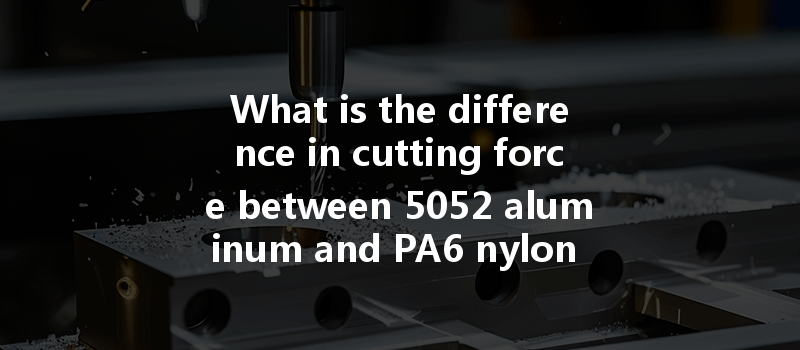Did you know that in the world of CNC machining, the choice of material can dramatically influence the cutting force required during manufacturing? For instance, a recent study revealed that different materials can require up to 50% more cutting force when machined under identical conditions, emphasizing the critical nature of understanding material properties. This blog post explores the differences in cutting forces between two significant materials used in CNC machining—5052 aluminum and PA6 nylon—while providing insights into the factors that influence these differences and offering practical solutions for optimizing machining processes.
—
Understanding CNC Machining
Before diving into the specifics of cutting force, let’s briefly revisit what CNC machining is and why it’s essential in modern manufacturing. CNC, or Computer Numerical Control, machining refers to using computerized controls to operate machine tools. This technology allows for the precise cutting, shaping, and finishing of materials ranging from metals to plastics, facilitating the mass production of various components across industries.
The Role of Cutting Force in CNC Machining
Cutting force is the force required by a tool to remove material from a workpiece during machining. This force is a critical factor as it affects the tool’s life, machining accuracy, surface finish, and even the overall efficiency of the manufacturing process. Understanding the differences in cutting forces between materials is vital for selecting the right tools, determining optimal cutting parameters, and ensuring effective operation.
Properties of 5052 Aluminum
5052 aluminum is a versatile alloy widely used in several industries due to its excellent corrosion resistance, weldability, and formability. This alloy features a medium strength level and is commonly used for making marine components, food processing equipment, and automotive fuel tanks.
Key Properties Include:
The combination of these properties makes 5052 aluminum an attractive choice for many applications, allowing it to excel in environments where corrosion and weight are concerns.
Properties of PA6 Nylon
Polyamide 6, commonly known as PA6 or nylon 6, is a synthetic polymer known for its excellent mechanical, thermal, and chemical properties. It is often used in applications requiring durability and flexibility, such as automotive parts, gears, and industrial components.
Key Properties Include:
The remarkable flexibility and resistance to wear and abrasion make PA6 nylon a popular choice for components that need to undergo repetitive motions or have frictional contact with other materials.
Key Differences in Cutting Force Between 5052 Aluminum and PA6 Nylon
The hardness and density of a material significantly influence the cutting forces experienced during machining. Generally, materials that are harder (like certain aluminum alloys) require higher cutting forces. As mentioned earlier, 5052 aluminum has a hardness of 60 HRB, while PA6 nylon has a Shore D hardness of
The geometry of the cutting tool plays a crucial role in the amount of cutting force required. With aluminum alloys, tools with sharper cutting edges and appropriate rake angles can help reduce cutting forces. On the other hand, machining PA6 nylon often benefits from tools designed with a flatter edge to prevent tearing and to promote smooth material flow.

The optimization of cutting speed and feed rate can mitigate cutting forces significantly. Generally, 5052 aluminum is machined at higher speeds and lower feed rates to achieve a better finish, which tends to increase the cutting force. In contrast, PA6 can handle higher feed rates due to its lower cutting resistance.
Practical Solutions for Managing Cutting Forces
Understanding the differences in cutting forces between 5052 aluminum and PA6 nylon is essential for optimizing machining processes. Below are several strategies that manufacturers can employ:
Selecting tools with specific geometries tailored for the machining material can greatly enhance efficiency:
Using cutting fluids can help reduce the cutting force and improve surface quality:
Addressing Challenges in Machining
While comparing cutting forces is essential, it’s equally important to address challenges that machinists face when switching between materials. Factors to consider include:
Understanding the wear patterns and potential failure modes of tools when transitioning from aluminum to nylon machining can help manufacturers prepare and adjust their operations accordingly.
Each material has different surface finish expectations that can affect subsequent production processes. It’s crucial to employ suitable finishing methods after machining, especially for aluminum, where a smooth finish may be necessary for aesthetic or functional purposes.
Each material responds differently under cutting conditions. Aluminum tends to produce continuous chips, while nylon may produce fibrous tendencies due to its plastic nature. Understanding these behaviors allows operators to adjust their strategies accordingly.
In summary, understanding the differences in cutting forces between 5052 aluminum and PA6 nylon is crucial for optimizing CNC machining operations. By recognizing the unique properties of each material and employing efficient cutting strategies, manufacturers can enhance their machining processes, increase tool life, and improve overall product quality.
As we navigate the complexities of CNC machining, it’s essential to remember that material choice is not merely a technical consideration but a strategic one that can impact manufacturing success. By employing the techniques discussed in this blog, businesses can ensure that they remain competitive in an ever-evolving market.
So, whether you are a seasoned engineer or a manufacturing manager, take a moment to reflect on your material selection processes. Knowing how to manage cutting forces effectively will undoubtedly aid in achieving optimal results in your CNC machining endeavors.






